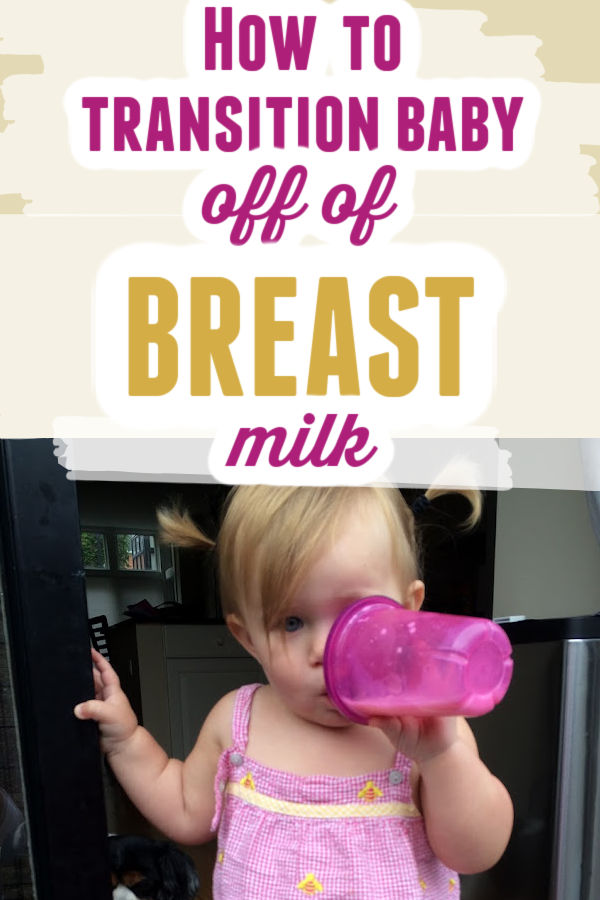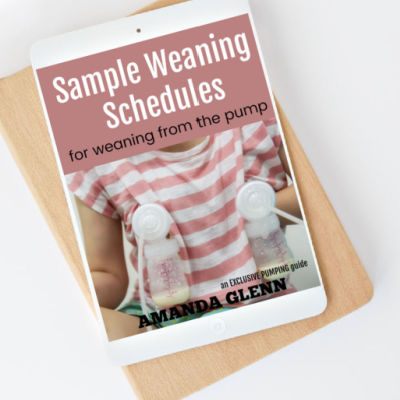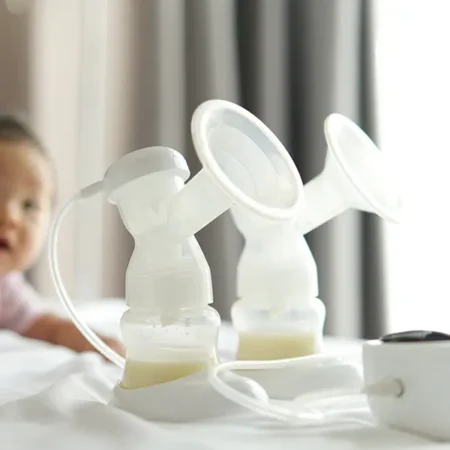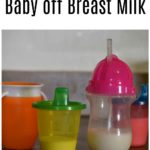At some point, it will be time to transition your baby off of breast milk onto a different milk, whether that is formula, cow’s milk, soy milk, etc. Here is how to make weaning your baby off breast milk to formula or milk as easy as possible.

This post may contain affiliate links, which means if you click a link and purchase something, I may make a small commission at no additional cost to you. I only recommend products I love! More information here.
What milk are you going to switch to?
The milk that you’re going to transition to depends on your baby’s age, any allergies or intolerances, etc.
1. Formula
If you stop pumping or nursing before your baby turns one, you will need to transition to formula.
In the United States, formula is pretty tightly regulated, so there isn’t a “best” type that you should switch to unless your baby has certain allergies or dietary requirements. Talk to your pediatrician if you have concerns.
2. Cow’s Milk
After your baby turns one, many parents switch to cow’s milk if their baby doesn’t have a dairy allergy or intolerance.
Talk to your pediatrician with any concerns you have with regard to the type of cow’s milk you plan to switch to (whole, 2%, etc.)
3. Alternative Milks
If your baby has dairy allergies or doesn’t tolerate it well, your doctor may suggest avoiding cow’s milk.
The most common alternative milks are soy, almond, hemp, and goat. More on these here.
Weaning Baby from Breastmilk to Formula or Milk
There are two ways that most parents switch their baby’s primary milk.
1. Switch cold turkey
Making the transition can be as easy as switching cold turkey: one feeding your baby gets breast milk, and the next he gets the milk or formula that you’re transitioning him to.
2. Gradual transition
You can also make the transition gradually, slowly adding more and more new milk to the old milk.
On my son’s first birthday, I put just a splash of whole milk into his breast milk bottle to see if he’d take it and whether he had an allergic reaction.
He didn’t seem to care one way or the other – or even notice the change – so over a week I gradually began increasing amount of whole milk in each bottle until he was only drinking cow’s milk.
When should you wean from the pump?
If possible, I would recommend waiting to wean from the pump until after you’re started the transition and you know your baby will take the new formula/milk.
Weaning can be unpredictable, and it can be really stressful if you start the transition when you’re almost out of frozen breast milk, and your baby refuses the new milk you’d planned on.
Want More Help Weaning? Use WEANING for 20% off
Switching to Sippy Cups
One other thing to think about: if you’re switching to milk at age one, you’re also at about the age that you make the transition from bottle to sippy cup.
If you’re nervous about these transitions, it might make sense to tackle them separately: get your baby drinking milk out of a bottle first, and then switch from a bottle to sippy cup, or vice versa.
(There’s no reason that babies can’t drink cow’s milk out of a bottle or breast milk out of a sippy cup.)
My son had a really challenging time switching to sippy cups – I literally bought 10 different kinds before finding one that worked.
Do you have any questions about transitioning your baby off of breast milk? Let us know in the comments!
Thinking about weaning from the pump? No idea where to start? Worried that you’ll get a clogged duct or mastitis when you stop pumping? Grab my one-of-a-kind guide here.
References
- Dinsdale, Elsa. “Early Exposure to Soy Isoflavones and Effects on Reproductive Health: A Review of Human and Animal Studies.” https://www.ncbi.nlm.nih.gov/pmc/articles/PMC3257624/
- Gall, Stephanie. “An Updated Guide to Soy, Rice, Nut, and Other Non-Dairy Milks.” https://www.vrg.org/journal/vj2008issue1/2008_issue1_updateguide.php

















